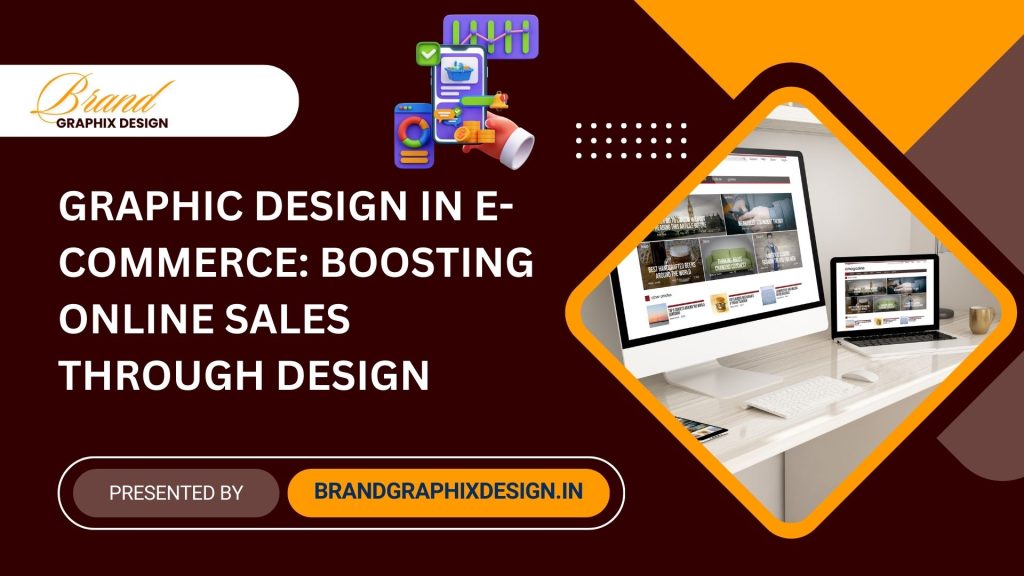E-commerce has changed the way we shop, and as more businesses go online, the role of graphic design has become even more critical. In a digital marketplace, how your website looks can directly impact your sales. An attractive and user-friendly design can make a huge difference in turning visitors into customers. So, how can you use graphic design to boost online sales? In this blog, we’ll dive deep into how graphic design plays a crucial role in e-commerce success and the steps to improve your design for better results.
1. First Impressions Matter: Creating a Visually Appealing Website
In e-commerce, the first impression can either make or break a sale. A visually appealing website captures attention and encourages visitors to explore more. If your website looks outdated or cluttered, potential customers might leave without even checking out your products. So, having a professional design is essential.
Steps to Create an Eye-Catching Website
- Use clean layouts: A clean and simple layout is easy to navigate. Avoid overcrowding your website with too many elements. Make sure there’s enough white space to give a balanced look.
- Focus on high-quality images: In e-commerce, product images are everything. Use high-quality images that clearly showcase your products. Ensure they are well-lit, sharp, and from multiple angles.
- Choose the right color scheme: The colors you use on your website should reflect your brand. If you’re selling luxury items, go for muted, elegant tones. If you’re targeting a younger audience, bold and vibrant colors can work well.
2. Importance of User-Friendly Navigation
No matter how good your website looks, if it’s difficult to navigate, users will quickly lose interest. In e-commerce, smooth navigation can make the shopping experience seamless, helping customers find what they are looking for without frustration.
How to Improve Website Navigation
- Use clear menus: Your menu should be straightforward, with categories that are easy to understand. Don’t overwhelm users with too many options. Stick to main categories, and use sub-menus if necessary.
- Add a search bar: Make it easy for users to find specific products by adding a search bar. Ensure the search feature works accurately and displays relevant results.
- Include filters: For websites with a large number of products, adding filters (by price, category, color, etc.) makes it easier for users to refine their search.
3. Product Pages that Convert
Your product pages are where conversions happen. A well-designed product page can convince a visitor to make a purchase. Each product page should provide all the necessary details in a clear and appealing way.
How to Design Product Pages That Sell
- Use high-quality product images: Just like on the homepage, high-quality images on product pages are crucial. Customers want to see the product in detail before buying it.
- Include detailed product descriptions: Provide a clear and concise description of each product, mentioning its features, benefits, and specifications.
- Add customer reviews: Product reviews build trust. Make it easy for customers to leave reviews and display them prominently on the product page.
- Use call-to-action (CTA) buttons: Your “Buy Now” or “Add to Cart” buttons should stand out. Use contrasting colors for CTA buttons so they are easy to spot.
4. Mobile-Friendly Design: The Key to Capturing Mobile Shoppers
With more people shopping on their smartphones, having a mobile-friendly website is no longer an option; it’s a necessity. A mobile-responsive design adjusts automatically to fit the screen size, ensuring a seamless shopping experience.
Steps to Optimize Your Website for Mobile Users
- Use a responsive design: Choose a website design that automatically adjusts to different screen sizes. Most website builders today, like Shopify and WordPress, offer responsive templates.
- Simplify your mobile layout: Keep your mobile website clean and easy to navigate. Avoid adding too many design elements that may clutter the mobile screen.
- Optimize images for mobile: Large images can slow down loading times on mobile. Make sure your product images are optimized for faster load times without compromising quality.
- Test for usability: Always test your mobile website to ensure that users can easily browse, add items to the cart, and complete the purchase.
5. Building Trust with Design Elements
Trust is a major factor when it comes to online shopping. Customers need to feel confident that your website is legitimate and secure before making a purchase. Graphic design plays a vital role in building this trust.
Design Elements That Build Trust
- Use a professional logo: A well-designed logo gives your brand credibility. Make sure your logo is visible on every page of your website.
- Display security badges: Show your customers that their data is safe by displaying trust badges like SSL certificates or payment gateway logos.
- Offer clear return policies: Make your return and refund policies easily accessible. Design these pages to be straightforward and transparent.
- Use customer testimonials: Display testimonials from satisfied customers on your homepage and product pages. These real-life reviews help build trust with potential buyers.
Good graphic design can significantly boost your online sales by creating a user-friendly and visually appealing experience for your customers. By following the steps outlined in this blog, you can improve your website’s design and increase your e-commerce sales.




